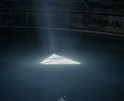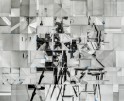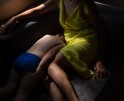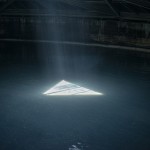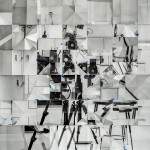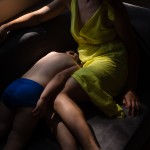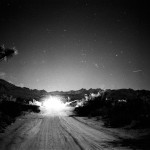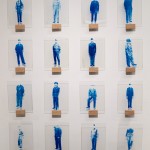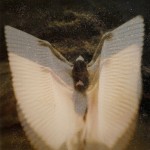The Dynamics of Photography and Disability: Jaklin Romine
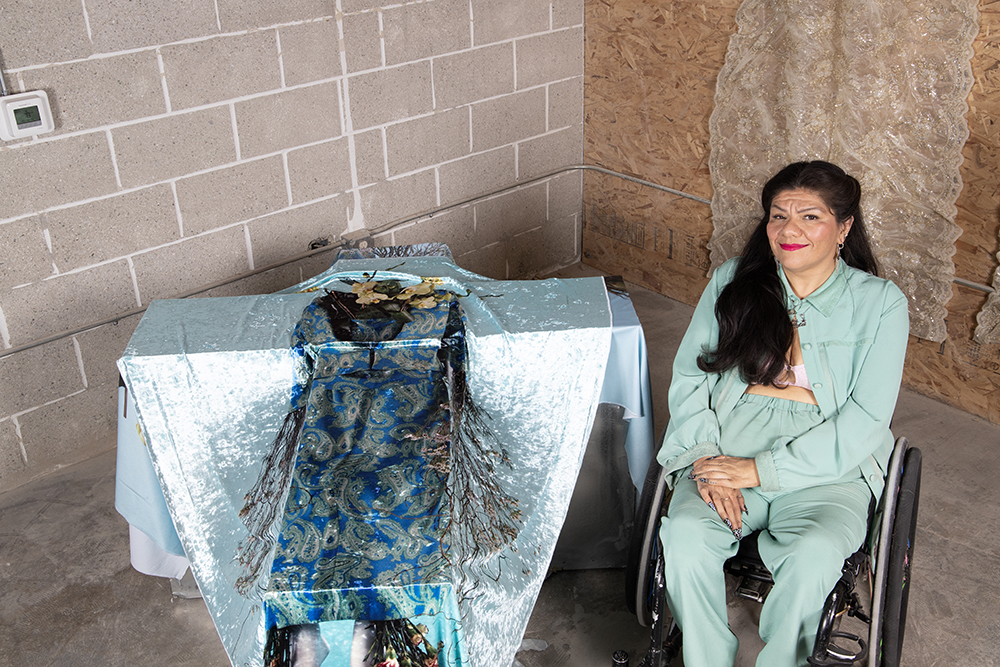
Portrait of Jaklin Romine, 2023. Photo by Star Montana. Image: Jaklin is in her studio next to a photographic sculpture of layered and draped velvet and chiffon fabrics printed with imagery. Jaklin has brown skin and long brown hair. She is wearing light blue pants, a long-sleeved shirt, and a red lip. She is seated in her wheelchair and behind her is a grey brick wall.
This week we are exploring projects by disabled/chronically ill photographers. The definition of dynamics is “forces or properties which stimulate growth, development, or change within a system or process.” Each of these artists is approaching their work in ways that embrace this meaning, enacting change and raising important questions about societal systems through their ideas, craft, and processes they use.
Jaklin Romine was born in Burbank, California, and currently lives in Pasadena. She lived in East LA [El Sereno] for 15 years, before that she lived in Echo Park, and grew up in Alhambra/San Gabriel. She studied Studio Arts at Cal State LA, and got her Masters of Fine Art at CalArts . Romine has been working professionally since 2015 and has been exhibiting in multiple group exhibitions across Los Angeles at Los Angeles Municipal Art Gallery, NAVEL, Noysky Projects, Superstition Gallery, One Archives, Night Gallery, Dominique Gallery, Avenue 50 Studio, Gallery 825, Eastside Cafe, Luckman Fine Arts Gallery and in New York at Flux Factory, Gibney Studios, New Women Space. She has lectured on her work at UCLA, NY Film Academy, Chapman University, SCRIPTS College, Torrance Art Museum, Cal Arts, as part of the ArtChangeUS: Arts in a Changing America five year initiative. Her work has been featured in the New York Times, Hyperallergic, Curate LA, KCET, on the cover, centerfold, and contributor of Full Blede and X-TRA. In 2019 she won the Rema Hort Foundation Emerging Artist Grant which assisted her in creating her first solo show, Why Bring Me Flowers When I’m Dead ? When You Had The Time To Do It When I Was Alive/Living With SCI, PSLA, Los Angeles, CA. Then the work from her solo show was curated into group shows at The Wignall Museum, Consulado General de Mexico, SUR Biennial at Rio Hondo College. Simultaneously, Jaklin created a zine from her photographic work and traveled to the Shanghai Art Book Fair, Independent Art Book Fair in LA & NY, Long Beach Zine Fest, San Diego Zine Fest, San Francisco Zine Fest, and Los Angeles Zine Fest. Currently, she is working on new photographic and installation work with artist Ginger Quintanilla. (Ginger Q)
Follow on Instagram: @jakioeoeo/
Artist Statement:
There are three cohesive areas to my practice: idea creation, working in collaboration with art production assistants, and performance. Within this dual role as artist and director, I found that the ability to formulate ideas and execute them is not limited to socially-constructed ideas of disability. I am in physical transition, and thus, wanted to create art that hovers within multiple art practices. I ambiguate the idea of the image, by turning prints into 3D sculptural objects. Using digital sublimation on chiffon, iridescent fabric, and vinyl creating a pliable image that hangs, droops, sags, and folds in unconventional ways. Breaking the language between image, object hood that circumvents the architecture it creates and inhabits as an installation. To complicate the situation I create fabric sculptures that are mounted behind or lay beneath the image that creates an abstraction of the content and the context of the image that breaks reality and the expected. Which allows the space I’ve created to float between installation, sculpture, and photography on top of a fabric scape that pushes photography into the third dimension. I take over spaces to confront my reality. While also confronting the intersection of feminist ideals that are formed by my identity as a disabled, queer, latinx, poc, living in the Southern California landscape. Where I use performance art to confront inaccessible art spaces in Los Angeles by documenting my body sitting outside for an entire art opening or closing. With zine/art book making as the last area of practice that I’ve picked backup this past year after a 15 year hiatus.
![02_LOSANGELESCONTEMPORARYARCHIVE[LACA]](http://lenscratch.com/wp-content/uploads/2023/12/02_LOSANGELESCONTEMPORARYARCHIVELACA.jpg)
Access Denied, Los Angeles Contemporary Archive [LACA] Image: A photo of LACA at night. There is a mesh metal door and through it is a long staircase is visible. Hung outside the gallery is a large banner with red text “ Access Denied” And longer text that explains Jaklin’s project and calling out LACA’s discrimination and inaccessibility.
MB: To start would you please tell us a little bit about yourself?
JR: My name is Jaklin Romine. I have been comfortable saying that I’m an artist for the past 10 years but I was a little bit scared to say that before. At that time, I wasn’t sure if I was really an artist or not. Until I felt like I was being validated when I started going to school. And I worked in art for a long time volunteering. I volunteered for MOCA, for the education department and I worked at a gallery and then I wrote for an online art publication called Platinum Cheese. I wrote for Platinum Cheese and then I did all these small, weird odd art things while going to undergrad, at Cal State LA. After that, I went to grad school at CalArts and then I got my Master’s from there in 2017. I went there for photo media.
And this, the first question that you have and the second question (What does disability mean to you personally and in your work?) kind of lead into each other. Part of the reason why I am the artist I am today and the work that I make now is because of being discriminated against from the very first time I ever went onto the CalArts campus for interview day. And, being discriminated against – in the sense that I couldn’t get into the photo lab that I was supposed to access when I was getting my master’s, and I couldn’t use the bathroom in the photo lab when I was trying to use it when I was there for my interview day. When I went to grad school and that happened to me I told myself “I don’t want to have to make work about my disability at all.”
But then I realized that there were more disability infractions while I was going to school there. And it was insurmountable, the amount of times that I had to experience this every day. It was basically experiencing some form of discrimination where I couldn’t use the bathrooms that were labeled accessible. Or I mean, I couldn’t use them, so I just had to go further away and sometimes I would have accidents or pee on myself and then it was too much for me to handle. So then I sued CalArts and forced them to become accessible.
That school has existed since the early seventies.
And other people (in wheelchairs) have gone to school there and taught there but no one had done anything about the lack of access. It was completely egregious since – they did not fix everything that was inaccessible. They only fixed the women’s bathrooms and not the mens. I was the only woman that sued and in order for them to make the men’s bathroom accessible another male wheelchair user would have to be discriminated against and then sue for access.
The first year I went to school there, I did not make work about my disability. I made work about being a woman and about being disabled only because it was part of my identity (but not fully apparent in the work) and also about my online dating experience. So I tried to make photographic sculptural work using an archive of images from my online dating experience and made huge Valentine’s Day cards with all the pictures of my text conversations and unwanted dick-pics. So that was my first try and then all this stuff happened to me when I went to school.
And then my second solo show, I mean my graduating thesis show. I presented the pictures that I used to sue them, as part of my thesis show. I printed the images on big huge vinyl banners. Pictures of the bathroom being labeled handicap accessible, me not being able to get into the bathroom stall and fit, not being able to see myself in the mirror. So, it went with the whole theme of the show which was about disability identity. It was not the token, but…conduit.
During my second year at CalArts, I artistically embraced my disability and started to make work about the experience on campus. In this earlier work, are the seeds for the later work that is Access Denied. I experienced discrimination for 2 years while going to school – even in classes being taken to galleries that were photography based, by photo teachers and I physically couldn’t get into them. So, the work started there in a class field trip at Bergamot Station. But I didn’t do anything with the video until after. But the work started in 2015.
I mean really, the early picture of me not being able to see myself in the mirror and you’re seeing the back of my head is literally the seed for the pictures that are Access Denied. But I didn’t take that picture and you couldn’t see my whole body. It was only the back of my head and shoulders and I wanted my whole body to be in the picture. That was really important to me.
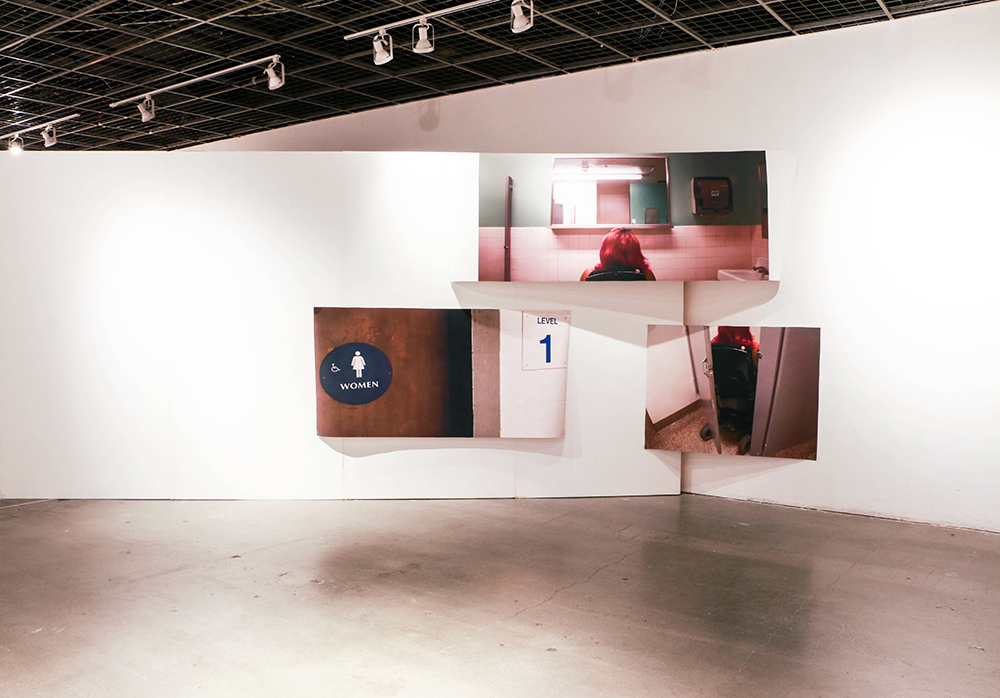
Graduate Thesis Show, CalArts, 2017 Image: Three large photos printed on vinyl displayed in a corner. The photos span over the corner, coming off the wall. The photos show the bathroom at CalArts labeled as accessible and Jaklin not being able to get into the stall or see herself in a mirror hung at an inaccessible height.
MB: Yeah, let’s talk more about Access Denied if you’re open to that. Last time we spoke, when the exhibition was at the U.N., there was something that you said at that time that really stuck with me and you echoed it very early on in this conversation too, which is that you don’t ask to make this work. You’re not looking to make it, but it happens to you.
JR: But see, it’s doesn’t just happen to me. I just happen to be the one person that documents it and talks about it.
MB: Yes.
JR: It would happen to anybody else who uses a wheelchair who has some kind of physical disability that uses a mobility device.
MB: You’re absolutely right. Yeah. Yeah, and this series has been going on since 2015 because of the abundance of inaccessible art spaces. So I just want to catch up with where this project is now. Both in your experiences of making the work and exhibiting it.
JR: The last time we talked the work was showing at the UN. And since that time I have experienced other artists and galleries blocking me from not being able to participate in their Instagrams, but we are actively showing together. So that’s hilarious and ridiculous. And you know, I had about three more experiences since this past year of Access Denied and there were times where I felt like I needed to -I was tired, basically, I became disillusioned and tired of making the work.
One, I’m tired of experiencing being left outside. But then there’s this whole experience when I do go to shows and the location is inaccessible and then people are like, “Oh, is she gonna take the picture?” “Why don’t you take the picture?” I know people are thinking that they don’t say it, but I know it’s in the back of everybody’s mind. Because that’s what I do, but it’s not what I do because I want to – I do it because I have to.
This last time at Jeffrey Deitch and the other time at my casual acquaintance’s opening of their galley, when I was at Sow & Tailor – the bathrooms. I saw them slowly renovating that space on their Instagram and I was like, “Oh, hopefully, they’ll get to the bathrooms.” So we’ll get to that. Cause I saw them put a lot of money into it and they never did. The bathrooms are too small for me to get into. And I was like, okay, I could get inside (the gallery) it was great. But I had to go to the bathroom when I was there but the bathroom was inaccessible so I couldn’t, and I had to leave.
So the gallery made it accessible for me to be able to get in but I still wasn’t able to use the bathroom. So I took pictures and video of the experience. [sidenote] They were also able to afford a cleaning lady to be actively working while the gallery show was happening, which I’ve never seen before. Like a maid literally picking up after everybody. And they were able to afford that but they were not able to afford to renovate the bathrooms. I didn’t say anything right away. And then I went to Jeffrey Deitch, I go into the show and it’s great beautiful, open area, and like when I went there when it was LAXArt. I don’t ever remember seeing this annex area part of the gallery where I can’t get in, I can’t look at the art. “I don’t wanna do this.” Literally, when I was there at the opening “I don’t wanna do this I don’t wanna take the pictures. I can’t. I’ll come back at some other time and I’ll do the work later.”
And so then I did that. And I really sat with it and then I realized, before I made the post, that I don’t wanna have to do this, but if I don’t nobody else is gonna talk about this. So then I went back to document and I continued the work.
Not too long after posting on IG Jerry Saltz, the New York Times art critic, has been following me since 2019, and has talked to me a little bit here and there on Instagram – saying he’s gonna show the Access Denied work. But after this one he finally did. He posted, he took the pictures and he reposted the Access Denied work and put it on his feed.
And I was like, yes, like this, this is something. This means something. This is somehow validated even though nobody will like it on a larger scale. But this is something. So the work has garnished the attention of important art people so that others are able to understand that work is valid (even though it’s not work that makes money) but it’s work that’s talking about something important.
You know, nobody wants to talk about disability discrimination. And I think that if I would just give up on it, literally just nobody would talk about it. And then I realized that that’s what it is and I put that in the post and I felt it because I really did and I will just continue to do it because I don’t want to and I just do it because I feel like I have to. Even the people who have me blocked have to see me.
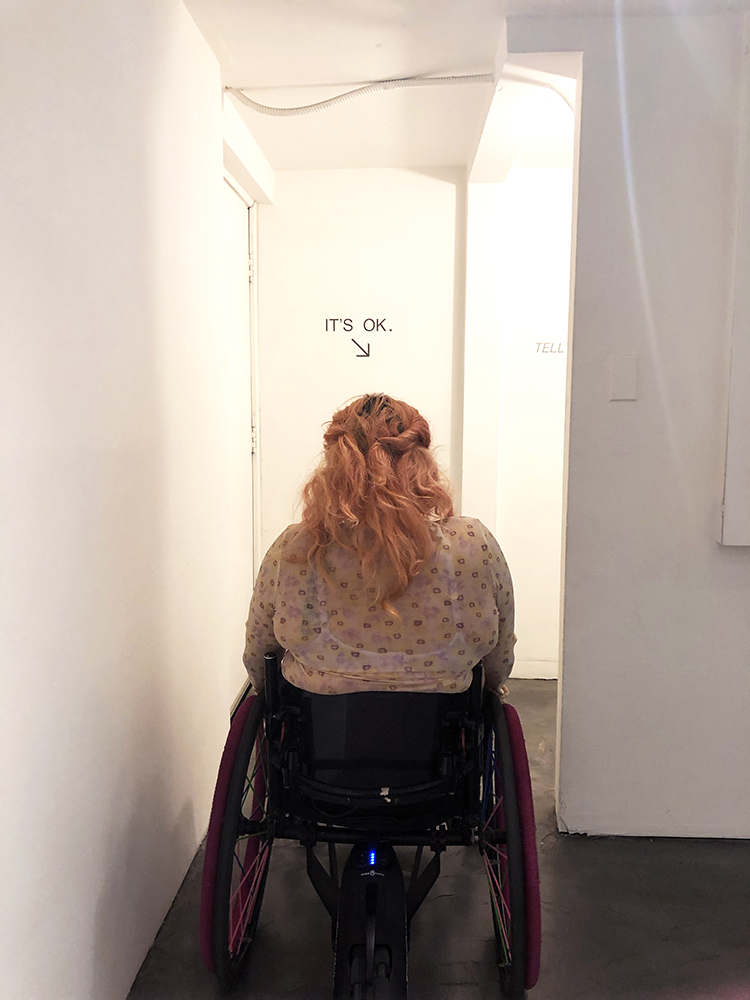
Access Denied, Charlie James Gallery, Image: Jaklin is sitting in her wheelchair with her back to the camera. Her hair is light pink and she is wearing a gauzy floral shirt. On a white wall in front of her is black text “It’s O.K.” with an arrow pointing down.
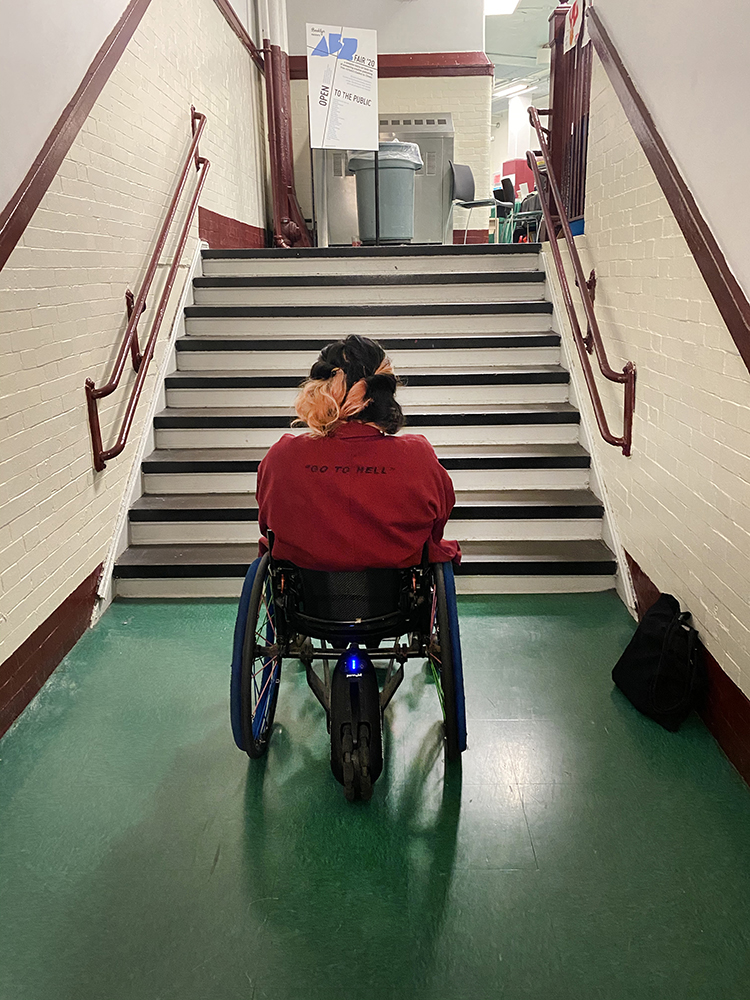
Access Denied, Image: Jaklin is sitting her wheelchair with her back to the camera and in front of a set of stairs. At the top of the stairs is a sign with text “Fair ‘20, Open to the Public”. Jaklin is wearing a red shirt with text “Go to Hell” on the back. Her hair is black and light pink.
MB: Your work is so important and valid, I’m glad that you’re getting that external validation. In hearing you talk about it I become very aware of just the amount of emotional labor that you take on personally. In making this work and feeling like you have to make it.
JR: I feel like over this past year – it’s just important for me to talk about. I’m just gonna continue to do it and it doesn’t feel so heavy anymore.
Before I felt heavy. Before every form of validation I’ve experienced, it’s felt lighter every time. Like lighter every time somebody recognizes it, lighter every time somebody of importance says that it needs to be paid attention to and they’re not talking just about the art.
They’re talking about the experience. And they’re talking more about the experience continuing to happen to other disabled people when talking about it. And that’s the part that goes beyond what I can do and what I am doing and what the work is trying to do and what the work is doing.
So that’s the part that I never thought would happen and I’m glad that that’s happening now. That it’s getting the right attention, I’ve lectured at colleges, I’ve talked even at CalArts about the work. The talk I had was organized by an outside organization called Art Changes US America. And l they brought me back onto campus and they (CalArts/ new President Ravi) wanted it to be moved off of campus and didn’t want me to be there because I could still sue them- they didn’t fix all of the ADA infractions. To them I’m a legal liability, literally.
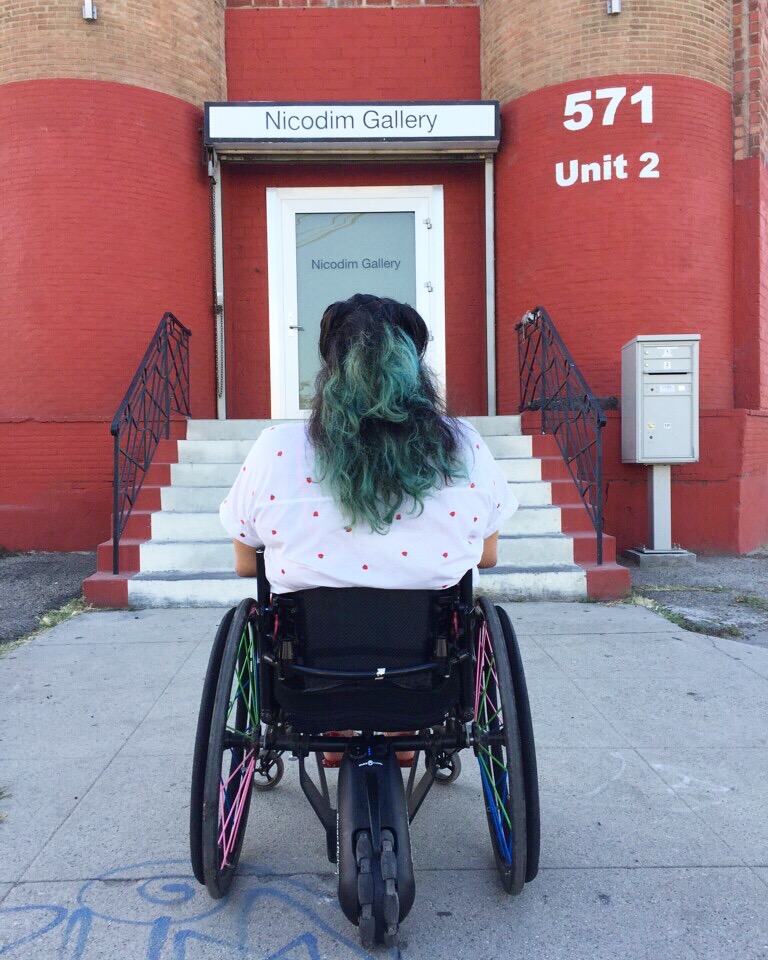
Access Denied, Nicodim Gallery, Image: Jaklin is in seated in her wheelchair in front of Nicodim Gallery. Her hair is dark brown with green tips and she is wearing a white shirt with red polka dots. Leading up to gallery is a set of stairs with metal railings.
MB: Another thing that resonated with me when we spoke you know last year about Access Denied was you sharing with me that you get feedback that the work is too upfront and it should be more passive and quiet. How this fits into the stereotypes of disability as passive and how this response is blame-shifting. And then how has it felt to go on and have your work receive this international praise and attention?
JR: It makes me feel great when I get the news. I feel great about it. And it feels amazing to understand that other people see that it should be seen on an international level like when we last spoke and it was at the U.N. But locally, in Los Angeles, in my city where I’m from it’s not really celebrated and shown like I would have preferred or liked it to be able to. The city in its way has shown up for me by making changes necessary – like some galleries moving or becoming accessible or finding funding and becoming accessible, I appreciate when those situations happen. But since we’ve last spoke, like I had the work shown in LAArtCore gallery in Los Angeles, but it was half accessible.
And that’s the only other time that I’ve shown it and it defeated the purpose of the work and I would have never show in an inaccessible gallery, if i knew beforehand. I would like to be able to show the Access Denied work or any of my work in LA proper but I haven’t really done that yet. So that’s the thing that’s hard about it.
I have received this international acclaim, but locally it’s not celebrated. I think because it’s pushing back against the city that I live in. I mean literally and I know that’s part of it. But … people are afraid to show it. Strangely enough I’ve literally been offered to show in an inaccessible gallery before and they said they would make it accessible for my show but then they would make an inaccessible right after.
I was like “No sorry I’m not gonna do that I can’t believe that you’re asking me and that you would do that. Why don’t you just leave it accessible?” “Why would you just make it accessible just for me for my show and then take it away?”
So dumb. Just like the freaking beach. Oh my gosh, I went to the beach with this person I’m seeing, and like they carried me into the freaking sand because they took the path out because it’s winter. Why would they take the wheelchair path out because it’s cold? Like why wouldn’t people with wheelchairs wanna go there all the time? Why not just have this access here all the time, they took it away.
That’s the one thing that I know that I have done to myself through my art practice is that I push myself away from my community by talking about this stuff. And I am an inside/outsider. I’m an inside/outsider art fan/art star.
Yeah, I mean, I’ve talked about being blocked by people and relationships dissolving because of the work and nobody talking to me about it. I mean, I think it’s weird and beautiful and strange and just indicative of the work. That’s the work I get recognized for the most strangely randomly. Like when I’ve been protesting recently, even people recognize me that I have never met. On the train, some girl, when I was getting off I was like kind of struggling, she waited for me and my friend. She’s like, “Are you Jaklin Romine? You make the access work.” I was like, “Yeah. Oh, thanks”. And she wasn’t in a wheelchair or anything. She was an able-bodied person. I think that was cool.
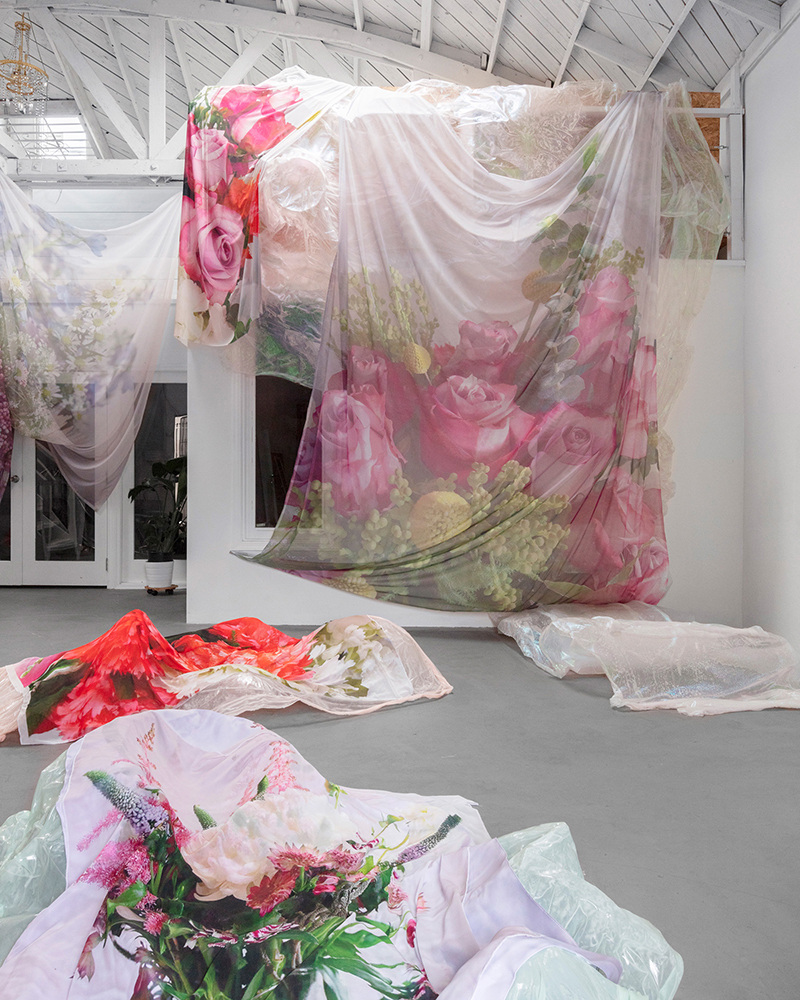
Installation image, Why Bring Me Flowers When I’m Dead? When You Had The Time To Do It When I Was Alive, 2018-2019 Image: Inside a white wall gallery are printed chiffon fabrics hanging from the ceiling, walls, and draped over sculptural forms. Printed on the chiffon are vibrant bouquets of flowers.
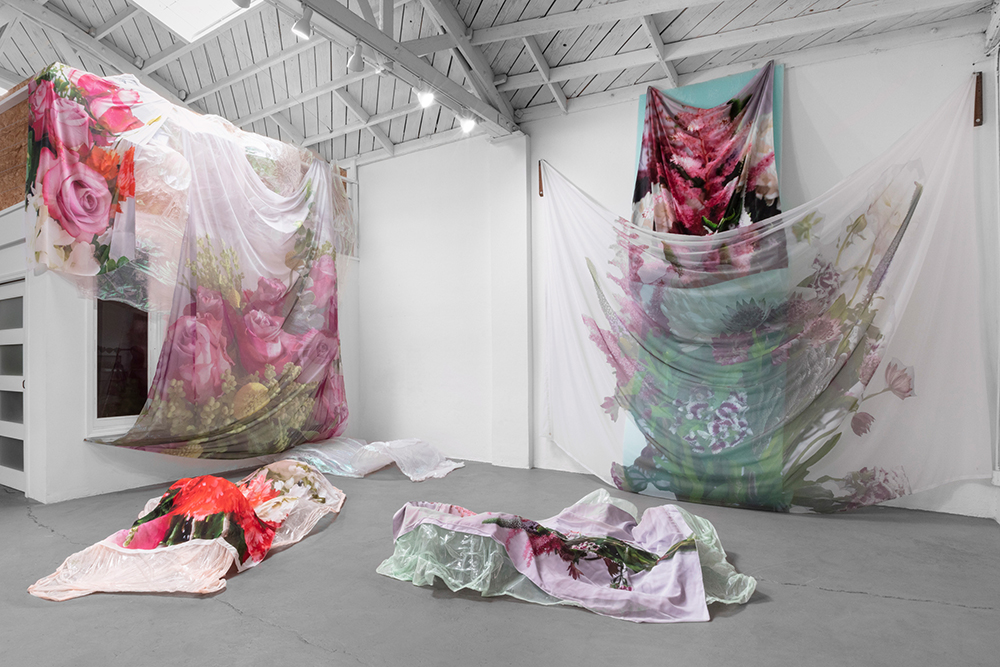
Installation image, Why Bring Me Flowers When I’m Dead? When You Had The Time To Do It When I Was Alive, 2018-2019 Image: Inside a white wall gallery are printed chiffon fabrics hanging from the ceiling, walls, and draped over sculptural forms. Printed on the chiffon are vibrant bouquets of flowers.
MB: You have had bodies of work that speak to your relationship with your grandmother. Why Bring Me Flowers When I’m Dead? When You Had The Time To Do It When I Was Alive. After her passing, She Breathes in Dirt and Exhales Flowers/Mejor Sola Que Mal Acompañada. Can you share more about the interconnected works? The resonance of flowers, printing on fabric, draping it over sculptural materials.
JR: My first series, Why Bring Me Flowers When I’m Dead? When You Had The Time To Do It When I Was Alive is a project that I started and created when my grandma was alive. I gave her 40 different bouquets of flowers over a 2-year period. And, then seriously, crazily, like as soon as that 2-year mark happened COVID happened. COVID happened and I used to get my grandma groceries, I used to go visiting, and then everything was just like shoo. It was like nothing. So it was very intense, like the halting of the project was like universally and also like the whole world changed at the same time.
So originally I took the pictures of the mannequins with the flowers. Which are the seeds for the project that is the second solo show, She Breathes In Dirt and Exhales Flowers. When I took those pictures, the idea was to combine, to combine my grandma’s art practice, which was her being a seamstress and I showed her ability to sew through all the outfits that she made.
So all the outfits that are on all the mannequins in the show and in the work are all outfits that my grandma made for herself or she bought for herself at one point in time. So when I first started taking the picture, she was still alive and I wanted to combine what, she wouldn’t have called it an art practice, but was her art practice (sewing by hand.) And I wanted to combine the flowers that I gave her when she was alive and then take pictures of combo. So I took the pictures of the mannequin inside my old studio and I got flowers that I gave her when she was alive and put them into the mannequins to give life to these outfits that she wasn’t wearing anymore.
But then when I got the time for the solo show, the meaning for the work kinda changed because my grandma had passed at that time. When I had the opportunity to do the show, I already had this work and so then the meaning changed it was no longer just putting flowers to combine it with the outfits that I gave her. It was then taking flowers and putting them back into outfits of a body that was no longer alive to then give it life. That’s the interconnected work with the connection with the flowers going from one series to the next. And then moving still with the theme of my grandma, but also in a totally different way. It’s a celebration of her and her abilities as well.
You know, for me ever since grad school I was really thinking about the medium of photography and then using my story of my life, my story with my grandmother, love for my grandma, the love for the flowers and all these different images – and using them as a powerful tool to be able to also talk about the medium of photography.
I have chosen to print my pictures on fabric. The first series I did, I just printed on poly chiffon and then black-backed iridescent spandex, like a gun metal to print all of my pictures of myself that were from my Living With SCI work.
But the flower work that I did, I printed everything on only chiffon so everything was sheer. And with this new series, like moving forward, I printed on crushed white velvet, pearl white iridescent spandex, and then also chiffon.
I printed each image on all 3 different fabrics. So I had access when I was installing to every image in every form of fabric because I knew that I was going to be using it to layer on itself and within each other. I’ve always tried to create different elements that are indicative within experimental photography. And also trying to implement that into my installations.
So when I use sheer fabric to layer, I usually put it on top and I usually use the solid images with the velvet and with the spandex underneath creating the effect of a double exposure. So I’m using tropes of photography. I’m using experimental ideas to be able to implement into a larger format. It can still read as if it was a photograph but then it’s still a totally different experience because I’m creating this environment by allowing the sculpture to hold the photographs and nothing – there’s no frame for the photograph. The photograph lays on top of the sculpture that is either on the floor or on the wall.
The sculpture I’m referring to is made out of foam and there’s a very huge picture of a mannequin wearing a white outfit with sunflowers and roses coming out of the neck, wrists, and legs. That was printed on a sheer poly chiffon and underneath it on the area of where the head is so that’s like a full-body portrait. That’s the big huge one, but underneath in the sculpture where the head is, there’s a close-up of the flowers that’s literally placed underneath where the head is. In the chest, there’s another set of flowers and then there’s a zoom-up picture that’s put in the center of the sculpture too, and at the bottom is like a close-up of the feet and then that’s put at the bottom.
So there are 3 different solid images underneath this big, huge basically blanket-sized picture and it’s all sheer and you can see through the solid pieces. It’s like a reification of the area that the picture is emphasizing.
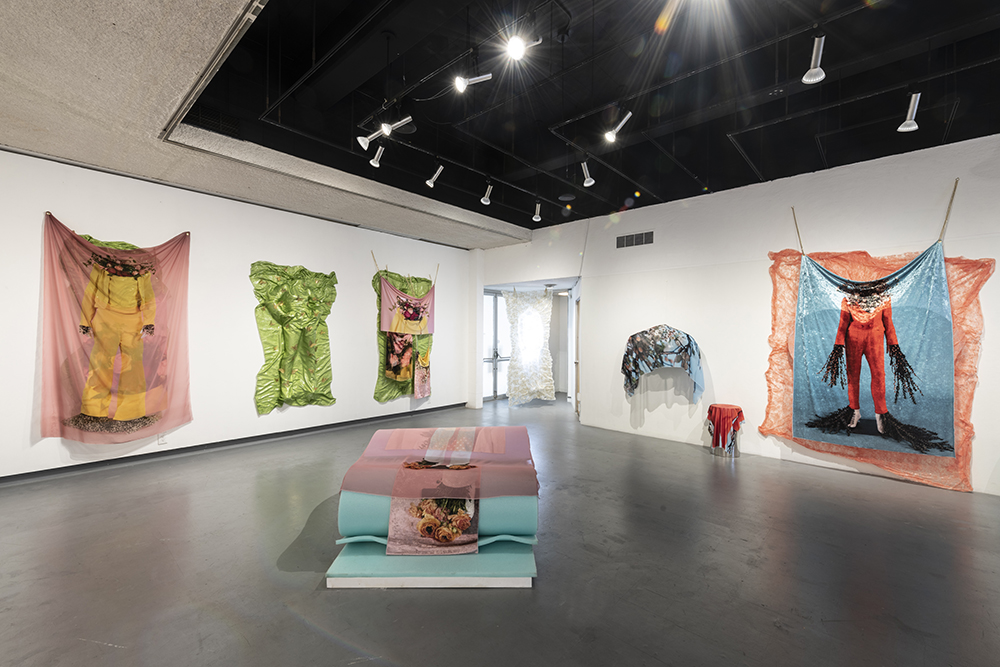
She Breathes in Dirt and Exhales Flowers/Mejor Sola Que Mal Acompañada, Image: Layered fabric printed with images of flowers and mannequins with flowers for limbs or heads are hung off the gallery walls or layered and draped over sculptural forms. Underneath some of the draping, bodily forms emerge. The fabrics are printed in vibrant blues, pinks, yellows, and greens.
MB: Wow, sounds incredible.
JR: It’s so cool. Sorry like I never get to talk about the photo part of it because I’m always talking about the grandma part of it that people are most interested in. This is a photo interview, so I’m talking about all the photography insights because I never get to talk about it.
So the whole idea, the creation of the work that I’m making, stems from the idea of making an image become an object. Because in art history and art theory, those things are inherently their own category. An object is just an object and an image is supposedly just an image. So my art practice has been continuously trying to circumvent and break the language and the understanding of what those two things are. So, draping the photograph on an object and giving it shape and form. I’m trying to give it image-objecthood.
In my recent solo show, I started working with metal as a sculptural element. I started using sheet metal, industrial chain, laser-cut mirrored steel, and found objects to create new sculptural objects. I’ve always used gold tone and brass throughout my art practice and then this was my first time using silver tone or metal silver tone. I made a very large 3D cross out of welded sheet metal. Also created a big rosary out of metal. It was 153” long, super oversized. And then lastly with the piece that was in the Los Angeles Times Image Magazine, I commissioned/designed my grandma’s name on laser-cut mirrored steel and silver chain. Using the material to continuously honor, celebrate, and elevate mi abuela and the medium.
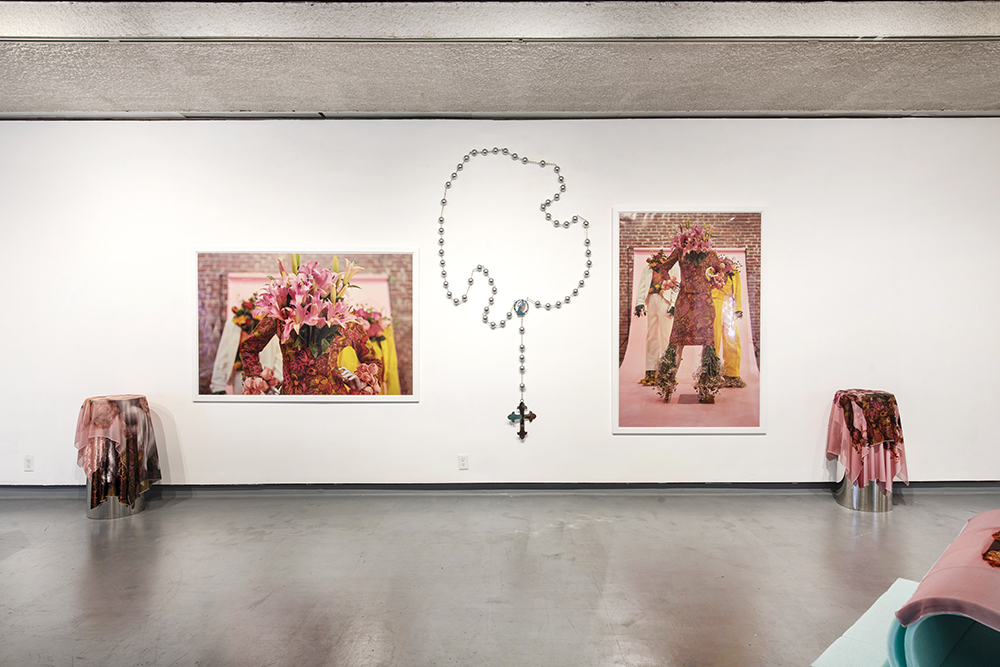
She Breathes in Dirt and Exhales Flowers/Mejor Sola Que Mal Acompañada, Image: Two photographs are displayed on the gallery wall. In between the two photographs is a large metal rosary with a cross. The photographs show mannequins dressed in her abuela’s clothing and flower bouquets for heads. Book-ending each image is a rounded sculptural form draped with pink fabrics with bouquets of flowers printed on them.
MB: Was there anything that you can kind of like pinpoint as that seed of starting to move photography outside of being two-dimensional and into 3-D form?
JR: Oh yeah, it was always to circumvent that and to go beyond photographic sculpture. The work is photographic installation. I started with vinyl, and then while in grad school Paul Sepuya was one of my mentors. He taught at CalArts for a very brief time. And he’s the one who suggested that I print on fabric and the graduation show at Night Galleries was the first time I printed on a poly-silk.
So right after grad school, I started practicing with the fabric medium. With images and work that I had already previously created, but hadn’t made new physical work with. Seeing how gravity takes hold and drapes, sags, folds, and lays fabric was key and then just going from there with experimentation. First I worked with vinyl and when it would bend it would crack and it would mess up the image and with fabric, that did not happen. Showing its versatility, a fabric picture printed as big as a car can fold up small enough to hide in a bag.Then be seen as a blanket. That’s exactly what protesters did at the Guggenheim. And they shut it down. They shut it down for Gaza with fabric printed images of the genocide.
MB: Do ideas of crip ancestorship (Stacey Milbern was writing about kinship with disabled folks not in their familial lineage but I feel like I see some of these connections in your relationship with your grandmother) and access intimacy play a role in this work?
JR: I had a hand me down wheelchair. The first wheelchair I had coming out of the hospital was a hand me down. I don’t think that there’s any crossover within the work, but I know that it’s inherently there because it’s like part of me and my identity, and like my grandma she grew up – her oldest brother was disabled. She grew up with seeing a disabled person be the main provider for her household.
My great uncle, my grandma’s oldest brother, dropped out of high school because their dad left them. My grandma was 10 and he just bounced and left with the neighbor lady. She had kids too and then they both started a new family altogether and he left 6 kids. And my great-uncle had polio and when he was older, he had 2 canes, but he only had one cane when he was younger. And he had a boot. I knew him, to have the extended boot on one leg, cause one leg was very significantly shorter and a regular shoe on the other foot.
My grandma always saw that disabled people could do many things so she never had any lowered expectations for me. I continue to have that for myself because I’ve always wanted my own independence. Being part of the disabled community is not a community of choice and initially I didn’t wanna have to be a part of it. I was not born disabled, not everybody knows my full story but I don’t wanna tell everything right now, right here, but I wasn’t born disabled, I was in an accident when I was 21. So I had a time when I had an able-bodied life.
And some people never have that experience. I have friends I’ve known who’ve been disabled their entire lives and who never had an experience outside of a wheelchair. So the disability life and experience has various different degrees of ability and a wide spectrum of help and care. That all depends on the variance of need of more help and care and the assistance of medical devices. However some able-passing people can physically and visually pass as non-disabled and don’t need as much care.
And, you know, the community at large is welcoming but nobody really wants to have to be a part of it. But once you’re in it, you have to learn to love yourself and be this new person or you don’t and have a really rough time. It’s a lot of learning and experimenting to understand how to do life a whole different way if you become disabled in the middle of your life. And if you are born disabled you have to always be an inventive problem solver.
You know, disabled people are really creative people. They continually have to solve all these weird problems that present themselves because society doesn’t change them because it’s not important to them. Being disabled, you have to learn how to do so many different things in so many different ways that you would never think that you would have to learn how to do sometimes just to function normally..
But we do it because society is still not set up for all disabled people. Like you still have freaking people on TikTok. I’m sorry, I have to talk about this here and I will say about it now. And also, Crutches and Spice, she also talked about it. There’s actual people still thinking that it’s somehow hurtful to them for me to exist as a person in real life in real-time outside of my house. Like, there’s a girl on TikTok who was like upset at the fact that there are groups of mentally and older disabled people who go for their probably daily activity and they are going to visit the part the the mall. And it offends her. It offends her that these people are outside in public and I don’t understand how in 2023 somebody can think that they can say these things in a public forum. And believe that they have validity and that they have every right to say what they’re saying that disabled people just stay inside.
MB: I saw that too and It was like, it’s like on some levels, like it’s appalling and also like not surprising that there’s still people who feel this way. And it was just ridiculous too – She’s like, “I’m not being rude” and it’s like “You’re being so offensive. Like you are you are being rude.”
JR: So, So rude, so offensive. But it’s like, you know. I don’t have a developmental disability, I mean what if I did then they would be making fun of me but I don’t and so I’m not gonna sit by and no other disabled people are going to sit by idly and take this and just say nothing.
But it’s because of thinking like this that things are not where they’re supposed to be and why this work still exists. This is why, that’s why I was bringing it back to that. This lady’s thought train, the ability to even have the privilege to think that somehow we’re still in the Victorian ages and wheelchair users shouldn’t be stuck inside. She is wrong and disabled people should be outside with accessible accommodations.
Okay. And that’s fucked up, but it’s only because we’re not that important to society and it costs too much money to make things accessible for us. But rarely is money allocated for access. It’s always an extra expense.
It’s not something that is considered in regular building planning. Even when freaking 45 was still in office and COVID was starting to pop up, he tried to dismantle parts of the ADA. It was very quiet and hardly anybody knew about it but, he was trying to make it so that new buildings could be built without being accessible and the only way that there could be change, if somebody was in a wheelchair went there and then they sued them after for access. So it would be cheaper for developers, so it could be cheaper for landlords. It could be cheaper for able-bodied people. Which would allow for infrastructure to be built that is not accessible and would push disabled people further away from having normal lives.

She Breathes in Dirt and Exhales Flowers/Mejor Sola Que Mal Acompañada, Image: An aerial view of the gallery installation. Below is a sculptural from in the shape of a cross. Over it are layered and draped fabrics. Through the layers, bouquets of flowers and body parts like feet and hands ebb and flow in and out of visibility.
MB: How did it feel when you were able to experience all the work in She Breathes in Dirt and Exhales Flowers/Mejor Sola Que Mal Acompañada installed together for the first time?
JR: It was very appropriate and very fitting that I got to host a show throughout the month of October and at the beginning of November, it’s the time for the ofrenda. I basically made an ofrenda in honor of mi abuela. I was glad that the work could live in a gallery for a month. My grandma was kind of the glue and since she passed everybody and everything has fallen apart. And the only person that came to see it outside of myself and my- I have – they’re very supportive mom’s side of my family so they’re still in my life but my dad was the only one that came. My dad has 2 older sisters and a younger sister, and a younger brother. And I have 6 cousins, none of them came. Only my dad did. And he didn’t come to the opening and he didn’t even tell me that he went. The gallery director actually told me that he went and we talked about it after. But he was overwhelmed. And it was beautifully and appropriately really just joyous to see it all put together.
Because it’s always been about making the work and doing something different with the medium of photography. Yet I am honored to tell my grandma’s story. The work that I created was to celebrate her. And it’s only because I’ve chosen to make this archive of love, I don’t know, it’s beyond that. but it’s a deep love I’ve been able to share with other people. This amore eterno carries my art further. I never knew if it was going to be important to other people but I knew it was important enough to me and I think that’s part of what people can feel and what people are drawn to. It’s powerful authentic ass art coming from a real he[art] place.
MB: Who are some of your artistic influences? Or influences… they don’t have to be from the art realm.
JR: Well, I mean, my photographic inspirations – you know I had this question many times when I was at CalArts and I’ll put this out there and you can put it in print – Michael Ned Holte told me many times that he was going to give me a list of Latinx women photographers that I was supposed to explore and understand and be widely open to, but I never got it. When I was at school I studied and was inspired by Laura Aguilar and like knowing that work. I hate to say this. But the seeds of my work do come from ASCO, it is ASCO even though I’m not considered in the ASCO crew. Hate to say that but yes, Harry Gamboa Jr.’s work has inspired and also emphasized the ick that comes with my work.
I really, have always loved Jo Ann Callis’ work. It is freaking amazing and beautiful and timeless. And really appreciating and understanding the grandeur of Gregory Crewdson’s work. And even though I don’t like all of his practices and I’m sure it’s there might be weird stuff going on there, but I really do like his work, visually anyway. Lastly Cindy Sherman and Ana Mendieta’s earth body work.
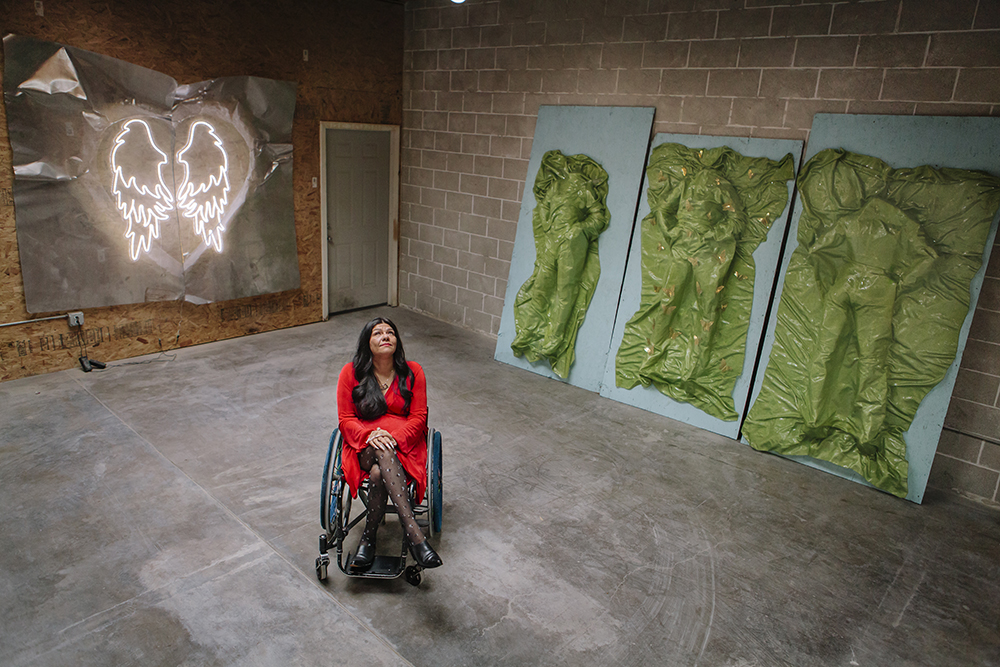
Portrait of Jaklin by Olivia Hemaratanatorn. Image: Jaklin is in her studio wearing a bright red dress. She is looking up and smiling. Behind her are neon lights in the shape of angel wings against metal. The form of a heart is visible through the metal. To the right are bodily forms created out of draped green fabric.
MB: What are you working on now? Is there anything new or upcoming you would like to share?
JR: Well, some of my work that we are talking about was recently featured in the Los Angeles Times Magazine, I thought that was really great and beautiful. I’m gonna be in a group show this next week at the Santa Ana Museum called Muzeo. I’m gonna be in a group show called Traditions, with work from my solo show. The large printed 4×5 photographs and the rosary are going to be featured. I’m gonna be having a residency with LACE Los Angeles Contemporary Exhibition Space. And I’m gonna be in a touring group show with I believe other disabled women that’s going to start in San Francisco in January with Root Division. And I’m also gonna be doing a residency with Pieter Performance Space.
Posts on Lenscratch may not be reproduced without the permission of the Lenscratch staff and the photographer.
Recommended
-
The 2024 Lenscratch 3rd Place Student Prize Winner: Mehrdad MirzaieJuly 24th, 2024
-
One Year Later: Nykelle DeVivoJuly 19th, 2024
-
One Year Later: Anna RottyJuly 18th, 2024
-
The Paula Riff Award: Minwoo LeeJuly 17th, 2024
-
Anastasia Sierra and Carrie Usmar: Talking MotherhoodJuly 16th, 2024



